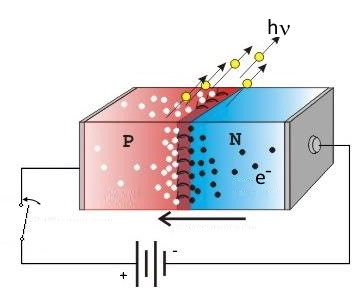







Search:
A LED is a → Diode doped in its P part by a scandium group element ( → element of group III of the periodic table ) and in its N part by a vanadium group element ( → Element from group V of the periodic table )
The passage of electrons between these elements via silicon during the correct polarization of the diode .....
 releases energy that is emitted in the form of light photons:
releases energy that is emitted in the form of light photons:
 The frequency $ \nu $ of the emitted photons and thus the wavelength $ \lambda $ of the emitted light depends on the difference between the energy levels from which the electron falls:
$ h \nu = E_i-E_f $ therefore
$ \lambda = \frac {h \cdot c} {E_i-E_f} = \frac {1240 nm \cdot eV} {\Delta E (eV)} $
With
Planck's constant $ h = 6.626 \cdot 10^{-34} Js = 4.13567 \cdot 10^{- 15} eV \cdot s $
the speed of light $ c = 2.99792458 \cdot 10^8\frac{m}{s} $
the energy difference before and after the transition $ E_i-E_f (eV) $
$ E_i-E_f $ essentially depends on the type of dopage elements
- Al // - Ga / As dopage gives a rather red light
- The Ga // - As / P dopage produces a more orange-colored light
- The Ga // - P dopage is more likely to give the green light
- The In / Ga // - N dopage produces a rather blue light
The frequency $ \nu $ of the emitted photons and thus the wavelength $ \lambda $ of the emitted light depends on the difference between the energy levels from which the electron falls:
$ h \nu = E_i-E_f $ therefore
$ \lambda = \frac {h \cdot c} {E_i-E_f} = \frac {1240 nm \cdot eV} {\Delta E (eV)} $
With
Planck's constant $ h = 6.626 \cdot 10^{-34} Js = 4.13567 \cdot 10^{- 15} eV \cdot s $
the speed of light $ c = 2.99792458 \cdot 10^8\frac{m}{s} $
the energy difference before and after the transition $ E_i-E_f (eV) $
$ E_i-E_f $ essentially depends on the type of dopage elements
- Al // - Ga / As dopage gives a rather red light
- The Ga // - As / P dopage produces a more orange-colored light
- The Ga // - P dopage is more likely to give the green light
- The In / Ga // - N dopage produces a rather blue light